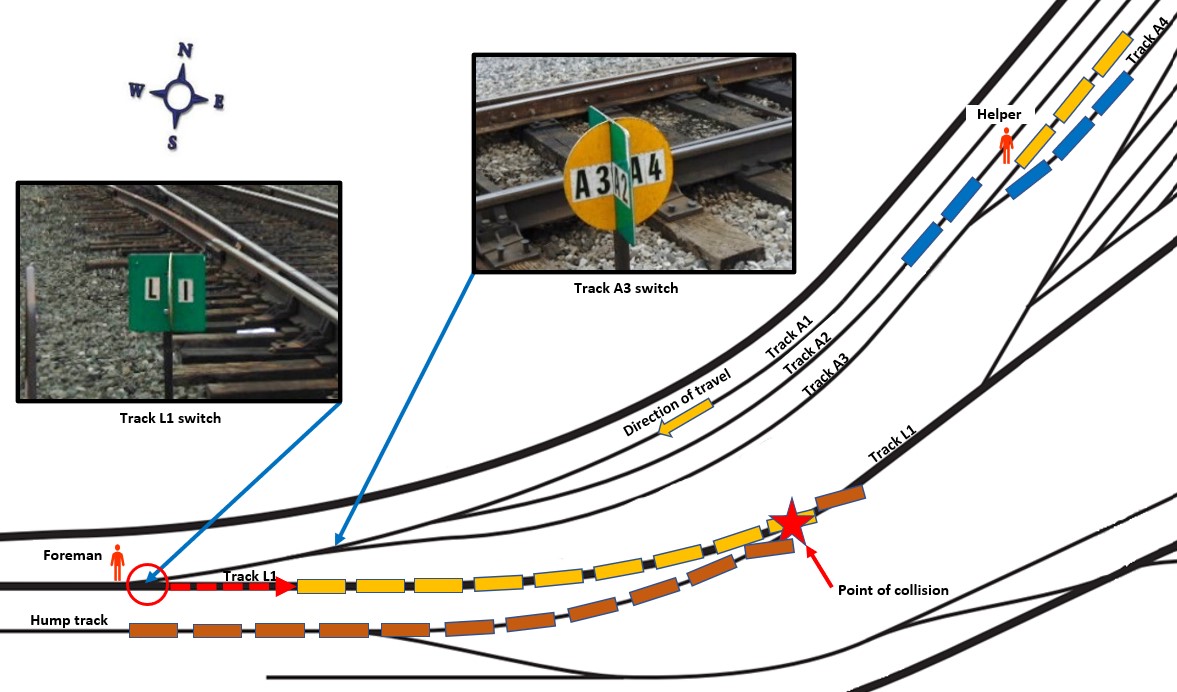22 July 2022
Director General, Rail Safety
Transport Canada
14th floor, Enterprise Building
427 Laurier Avenue West
Ottawa ON K1A 0N5
Subject :
Rail Transportation Safety Advisory Letter 02/22 (occurrence R22T0060)
Operational experience of employees paired for remote control locomotive system yard assignments
On 16 April 2022 at about 1300 Eastern Daylight Time, Canadian Pacific Railway Company (CP) remote control locomotive system (RCLS) yard assignment HT15-16 (the assignment)Footnote 1 collided with a stationary yard assignment while performing switching operations in the northwest section of CP Toronto Yard in Toronto, Ontario. As a result of the collision, 9 cars sustained damage, and 7 of these 9 cars derailed. There were no injuries.
The assignment crew, a foreman and a helper, had been instructed to pull a cut of 25 cars westward from track A1 and shove them eastward into track A3, where some of the cars would be coupled to other cars in track A3.
The foreman planned to pull the cut of cars westward on track A1, clear the track A3 switch and line the switch for the eastward movement. After lining the track A3 switch, the foreman planned to pass RCLS control to the helper, who would control the assignment as it shoved the cars eastward on track A3 to make a coupling with cars that already occupied track A3. Since the intended route was clear of equipment between the track A3 switch and the helper’s location, and no other movement had access to the track, there was no requirement for the assignment crew members to physically ride the leading end of the assignment.Footnote 2
The foreman pulled the cut of cars from track A1, but instead of clearing the track A3 switch, he continued further west, cleared the track L1 switch, then detrained and lined the track L1 switch for the eastward movement.
He then passed control of the assignment to the helper. The helper was positioned about 2000 feet eastward, adjacent to the car where the coupling was to be made, and was unable to observe the movement, nor was he required to. Once he had control, the helper initiated an eastward movement of the assignment, expecting the cars to enter track A3 as planned. Instead, the assignment entered track L1 and travelled eastward for about 860 feet, where it side-collided with another assignment that was stationary on the hump track and partially occupied track L1 (Figure 1).
In this occurrence, both the foreman and the helper had limited operating experience. They were hired in February and March 2021 respectively and were considered fully qualified after 6 months of training. The experience they had gained in the 6 months since qualifying was not exclusive to switching operations using an RCLS in CP Toronto Yard. Despite both having limited yard operating experience, they were paired together to work the RCLS assignment.
Previously documented concerns with inexperienced employees paired for remote RCLS yard assignments
In 2006, the Federal Railway Administration (FRA) in the United States published a report titled Safety of Remote Control Locomotive (RCL) Operations. The report identified concerns related to human factors in RCLS operations, including operator training, preparation, and experience. It stated, in part:
The combination of increase in new hires with no prior railroad experience (especially switching experience) and self-reported and observed (via Foster-Miller research) inadequacies in RCO [remote control operator] training and preparation have the potential to be problematic and may lead to RCO errors, as well as accidents/incidents due to a lack of knowledge or understanding of RCL [remote control locomotive] operations, including switching operations.Footnote 3,Footnote 4
The report also identified concerns regarding the large influx of new workers in the railway industry. It noted that, historically, employees acquired years of operational experience before learning to operate an RCLS. Through this experience, employees became familiar with railroad safety, operating rules, and the intricacies and nuances of working within busy classification yards, all important elements in maintaining a safe working environment. Additionally, the report identified the pairing of inexperienced employees as a potential significant future safety issue.
Since 2016, the TSB has conducted 4 investigations that involved uncontrolled movements in yards in which the inexperience of operating crews was considered a contributing factor.Footnote 5 In 1 of the 4 investigations, an RCLS operator sustained fatal injuries.Footnote 6 In each of these 4 cases, the TSB identified that yard positions are typically assigned to operating employees with the least seniority, and it is not uncommon for a yard crew operating an RLCS to consist of 2 conductors with minimal yard operational and RCLS experience. As a result of these investigations, in TSB Railway Investigation Report R17W0267, the Board expressed a safety concern regarding the pairing of inexperienced RCLS operators.
In this occurrence, both assignment operators lacked comprehensive Toronto Yard experience, yet were paired together to work the RCLS assignment. The foreman did not realize that he had lined the cut of cars for the wrong track, even though both switches were visibly marked. With regards to the helper, although not required to monitor the movement, a more experienced operator may have taken a position in an area from which the movement could have been observed.
Since the challenges of pairing of inexperienced operators continues for various reasons, Transport Canada may wish to consider an alternate approach to pairing of employees to work RCLS yard assignments to ensure that newly qualified employees are mentored by more experienced employees until they gain sufficient expertise to operate safely.
The TSB would appreciate being advised of TC’s position on this issue, and what action, if any, will be taken in this regard.
Yours sincerely,
Original signed by
Vincenzo De Angelis
Director, Investigations (Rail/Pipeline)
Transportation Safety Board of Canada
CC.
-
Director, Regulatory Affairs
Railway Association of Canada -
Assistant Vice President, Safety
Canadian National Railway -
Director, Regulatory Affairs
Railway Association of Canada
